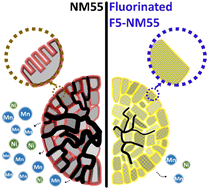A fluorinated O3-type layered cathode for long-life sodium-ion batteries†
Abstract
O3-type layered transition metal oxide cathodes, one of the best candidates for practical sodium-ion batteries, do not meet the performance standards required for practical application. These cathodes suffer rapid capacity loss during cycling owing to their inherent structural and chemical instability. In this study, we suggest a promising fluorination strategy to extend the cycle life of these cathodes by improving their mechanical integrity and protecting their surfaces against electrolyte attack. Fluorination not only inhibits the microcracking of cathode secondary particles but also suppresses surface degradation, i.e., the formation of an electrochemically inactive NiO-like rock salt phase and dissolution of transition metals. Consequently, an optimized Na0.95[Ni0.5Mn0.5]O1.95F0.05 cathode demonstrates outstanding cycling stability, and a resulting pouch-type full cell featuring a hard carbon anode achieves a capacity retention of 92% after 500 cycles. Hence, the proposed distinctive fluorination strategy presents an effective approach to the extension of battery life and improvement in the viability of O3-type layered transition metal oxide cathodes for practical sodium-ion batteries.



 Please wait while we load your content...
Please wait while we load your content...